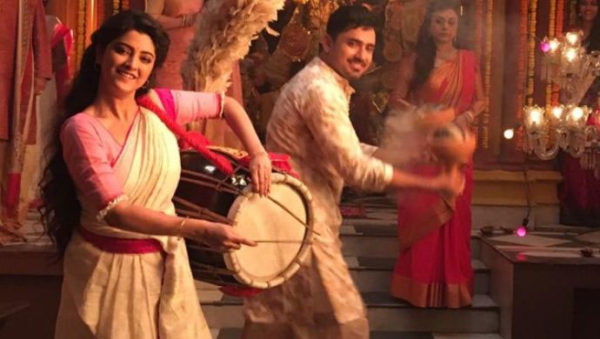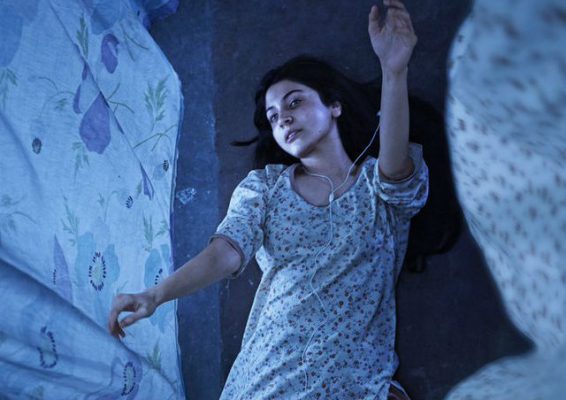Durga Puja is incomplete without dhak– the loud, rhythmic beats of a drum-like musical instrument, traditionally played by at least two men.
While tradition mandates dhakis (people playing the dhak) to play the instrument during rituals, the frenzied beats go up several notches during dhunuchi naach– a light-hearted, fun dance that sees people dancing with burning coconut husk and dhuno (frankincense) in an earthen pot.
There is dance and cheer when the people from the ‘dhaki community’ play their instrument, particularly during special pujas every year, says 24-year-old Mampi Das, a woman dhaki from Maslandapur in North 24 Parganas, a district in the southern part of the State.
Although the dhak has been traditionally played by men for centuries, there has been a recent rise in the number of women who have begun performing in this space, says 24-year-old Mampi Das, a woman dhaki from Maslandapur in West Bengal’s North 24 Parganas district.
Women say that they have finally begun monetising their talent in recent years and establishing a career for themselves.
However, the lockdown due to the Covid-19 pandemic, has given way to a number of problems for these women. They now say that they are fighting with the idea of fewer performing spaces, lower-income and dwindling recognition.
Roots
“It was not until 2010 that women dhakis were seen in the limelight at large-scale events, beating dhaks,” said Gokul Chandra Das, a renowned dhaki.
Das is one of the few dhakis to have gained worldwide recognition.
Originally made of wood and animal hide, dhaks originally weigh at least 15 kgs. When more women began enrolling in classes to learn the dhak, Das changed the material for the construction of the instrument to make it lighter. Steel replaced wood, and fibre replaced animal hide. The new instrument now weighs eight kgs lighter, he says.
“The change has helped us carry the dhak for four hours or more, even though the tune is slightly less sweet than the original one,” said Priyanka Mondal, a 29-years-old woman dhaki, who is one of his students.
According to Das, the idea of creating a more prominent space for women, first began in 2010 when he went on a month-long tour with tabla maestro Zakir Hussain to Los Angeles. During his trip to a saxophone store, he saw a foreign woman play a range of instruments as a demonstration to the customers. This inspired him to begin a training school to teach women to play the dhak in Maslandapur.
Initially, it was six of his close women relatives who joined. The movement later grew and led to the joining of 80 women, between the age group of 14 and 46, he says.

Change
Currently, there are at least four separate groups of women who play the dhak. They are located in Muslandapur, Arambagh, Murshidabad, and Howrah. With time, the women say that their popularity has risen.
A team of 10 people are booked for each event. The women usually have three to seven bookings each day during Durga Puja. Apart from this, they also perform at events including Khuti Puja, Rath, and Poila Baishakh. Recently, they have also been invited to contests, film and television shootings, festivals, hotel inaugurations and song recording sessions. The work goes around the year and Durga Puja is considered to be peak season.
With time, the women have also been invited to cities including Delhi, Mumbai, Guwahati, Srinagar and Bangalore during the Puja time. The group earns between Rs 1 lakh to Rs 5.5 lakh for each event and the booking begin as early as six months ahead of each event. They get between 30 and 35 bookings, and have become a novelty and sought-after during festivals.
Initially though, gaining support among the public was difficult. To locals, women playing dhaks was an unusual sight.
When a 19-year-old Mampi Das first picked up a dhak, it felt strangely relieving to her.
“My grandfather was a dhaki but I was told that girls don’t play dhak so I never tried before,” she says. Das, now 24, is one of the female dhakis who trained under Gokul Chandra Das. She lives at the training centre with her husband and in-laws in a kutcha house.
Like many women dhakis in Maslandapur, she says that she has longed to play dhak from a young age but was denied the right to pick one because of her gender. It was one year after her marriage that she sought her husband’s permission to play.
Priyanka Mondal, too, required the approval of her in-laws and husband to join the dhaki training. However, she says that her family readily agreed to it.
“We do not come from a standard family. To earn a living, both my wife and I need to work. I like that my wife plays dhak. She inspires me to pick one up too,” said Sayan Mondal, Mondal’s husband who works as a tuition teacher for students between classes VIII to X.
The first day 29-year-old Mondal held a dhak in her hand, she said that it slipped.
“I was sweaty and I was nervous but Guruji (Gokul Chandra Das) taught me the correct posture and gave me the strength to handle the instrument. I have not held back since,” she said.
Representation
On July 13, Bengali entertainment channel Zee Bangla aired the first episode of Jamuna Dhaki, a serial starring actors Sweta Bhattacharya and Rubel Das. The show was advertised as one which would portray the struggles of a woman dhaki.
Mampi Das who watched the show then, says that she initially liked how it highlighted their miseries. “However, in an episode the protagonist and a boy from high-society fall in love. The family members keep taunting the girl about her profession. I hated it. It reminded me of days when people used to taunt me. I wanted to reject the negativity and instead focus on what I have set out to do,” she said.
Gokul Chandra Das called it an imaginative serial. The plotline, he says, does not showcase the women’s training and instead makes it a family drama.

Jamuna-Dhaki
According to Garima Dhabhai, an assistant professor at Presidency University in Kolkata, when popular media like television, shows a woman dhaki as the protagonist, it will indicate the normalisation of this profession and legitimise it through popular culture.
“Depiction matters. In case the narrative doesn’t take into account the everyday life of a woman dhaki, it will nullify the protagonist’s identity of being a dhaki. By generalising the plotline into a love story and a family drama, the point of the woman being a dhaki is lost,” said the professor.
Lockdown
Despite the representation on screen, there have been only two bookings each for events this year for a majority of women dhakis.
According to Kingshuk Maitra, the working president at Suruchi Sangha, a puja organising committee, they have been inviting women dhakis for three years now and this year will be no different.
“It has become a ritual now. We want to be a platform for their talent,” he says.
Recommended
Gokul Chandra Das says that the cancellations have hit them hard.
The lack of bookings has pushed a number of these women to take up the alternative earning options. According to Modal, the women have stepped up to ensure that families stay afloat and eat meals during the lockdown. They have been sewing churidars, bottoms, tops, and packaging kids clothing.
“Playing, practising and performing gives one a degree of independence and a voice. By joining the group, a lot of us have ended up discussing a lot of issues, some pertaining to household and others invaded by politics,” Priyanka says.
As the community enlarges, it will bring a stronger voice and more resilient beats.



